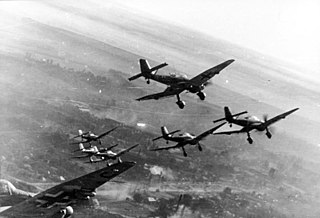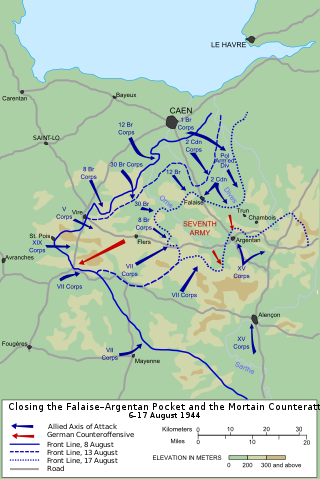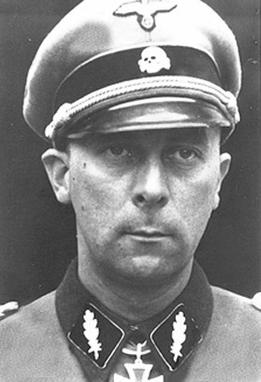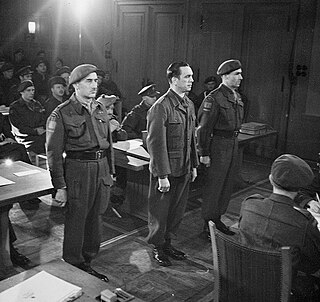
Blitzkrieg is a word used to describe a combined arms surprise attack, using a rapid, overwhelming force concentration that may consist of armored and motorized or mechanized infantry formations, together with artillery, air assault, and close air support. The intent is to break through an opponent's lines of defense, dislocate the defenders, confuse the enemy by making it difficult to respond to the continuously changing front, and defeat them in a decisive Vernichtungsschlacht: a battle of annihilation.

Johannes Erwin Eugen Rommel, popularly known as The Desert Fox, was a German Generalfeldmarschall during World War II. He served in the Wehrmacht of Nazi Germany, as well as in the Reichswehr of the Weimar Republic, and the army of Imperial Germany.

Decision Before Dawn is a 1951 American war film directed by Anatole Litvak, starring Richard Basehart, Oskar Werner, and Hans Christian Blech. It tells the story of the U.S. Army using potentially unreliable German prisoners of war to gather intelligence as clandestine "line-crossers" in the closing days of World War II. The film was adapted by Peter Viertel and Jack Rollens (uncredited) from the novel Call It Treason by George L. Howe. The film was a critical success and was nominated for the Academy Award for Best Picture.

The European theatre of World War II was one of the two main theatres of combat during World War II, taking place from September 1939 to May 1945. The Allied powers fought the Axis powers on both sides of the continent in the Western and Eastern fronts. There was also conflict in the Scandinavian, Mediterranean and Balkan regions. It was an intense conflict that led to at least 39 million deaths and a dramatic change in the balance of power in the continent.

The Western Front was a military theatre of World War II encompassing Denmark, Norway, Luxembourg, Belgium, the Netherlands, the United Kingdom, France, and Germany. The Italian front is considered a separate but related theatre. The Western Front's 1944–1945 phase was officially deemed the European Theater by the United States, whereas Italy fell under the Mediterranean Theater along with the North African campaign. The Western Front was marked by two phases of large-scale combat operations. The first phase saw the capitulation of Luxembourg, Netherlands, Belgium, and France during May and June 1940 after their defeat in the Low Countries and the northern half of France, and continued into an air war between Germany and Britain that climaxed with the Battle of Britain. The second phase consisted of large-scale ground combat, which began in June 1944 with the Allied landings in Normandy and continued until the defeat of Germany in May 1945 with its invasion.

The Falaise pocket or battle of the Falaise pocket was the decisive engagement of the Battle of Normandy in the Second World War. Allied forces formed a pocket around Falaise, Calvados, in which German Army Group B, consisting of the 7th Army and the Fifth Panzer Army, were encircled by the Western Allies. The battle resulted in the destruction of most of Army Group B west of the Seine, which opened the way to Paris and the Franco-German border.

The 2nd SS Panzer Division Das Reich or SS Division Das Reich was an armored division of the Waffen-SS of Nazi Germany during World War II.

Wilhelm Mohnke was a German military officer who was one of the original members of the SchutzstaffelSS-Stabswache Berlin formed in March 1933. Mohnke, who had joined the Nazi Party in September 1931, rose through the ranks to become one of Adolf Hitler's last remaining general officers at the end of World War II in Europe.

The Battle for Caen was a military engagement between the British Second Army and the German Panzergruppe West in the Second World War for control of the city of Caen and its vicinity during the Battle of Normandy.

The Ardenne Abbey massacre occurred during the Battle of Normandy at the Ardenne Abbey, a Premonstratensian monastery in Saint-Germain-la-Blanche-Herbe, near Caen, France. In June 1944, 20 Canadian soldiers were massacred in a garden at the abbey by members of the 12th SS Panzer Division Hitlerjugend over the course of several days and weeks. This was part of the Normandy Massacres, a series of scattered killings during which up to 156 Canadian prisoners of war were murdered by soldiers of the 12th SS Panzer Division during the Battle of Normandy. The perpetrators of the massacre, members of the 12th SS Panzer Division, were known for their fanaticism, the majority having been drawn from the Hitlerjugend or Hitler Youth.

Hubert Meyer was a German SS commander during the Nazi era and a post-war activist. In World War II, Meyer served in the Waffen-SS and had junior postings with the Leibstandarte SS Adolf Hitler; he briefly commanded the SS Division Hitlerjugend in 1944. After the war, he became active in HIAG, a Waffen-SS negationist lobby group, and was HIAG's last chairman before the group dissolved in 1992.

Operation Overlord was the codename for the Battle of Normandy, the Allied operation that launched the successful liberation of German-occupied Western Europe during World War II. The operation was launched on 6 June 1944 (D-Day) with the Normandy landings. A 1,200-plane airborne assault preceded an amphibious assault involving more than 5,000 vessels. Nearly 160,000 troops crossed the English Channel on 6 June, and more than two million Allied troops were in France by the end of August.

The 17pdr SP Achilles is a British variant of the American M10 tank destroyer armed with the British Ordnance QF 17-pounder high-velocity 76.2 mm (3-inch) anti-tank gun in place of the M10's considerably less powerful 3-inch Gun M7. A total of 1,100 M10s were converted to Achilles, making it the second most numerous armoured fighting vehicle to carry the 17-pounder gun, behind the Sherman Firefly tank.

The Battle of Le Mesnil-Patry during the Second World War, was the last attack by an armoured battle group conducted by Canadian troops in Normandy in June 1944. The Queen's Own Rifles of Canada of the 8th Canadian Infantry Brigade of the 3rd Canadian Division, supported by the 6th Armoured Regiment of the 2nd Canadian Armoured Brigade attacked the village of Le Mesnil-Patry in Normandy, to advance southwards towards the higher ground of Hill 107 to the west of Cheux. The attack was intended to support a larger operation by the 50th (Northumbrian) Infantry Division and the 7th Armoured Division to capture the city of Caen and to advance in the centre of the bridgehead next to the First US Army. The battle was a German defensive success but the greater German objective of defeating the invasion by a counter-offensive also failed.

A hypothetical military victory of the Axis powers over the Allies of World War II (1939–1945) is a common topic in speculative literature. Works of alternative history (fiction) and of counterfactual history (non-fiction) include stories, novels, performances, and mixed media that often explore speculative public and private life in lands conquered by the coalition, whose principal powers were Nazi Germany, Imperial Japan, and Fascist Italy.
Panzer ace is a contemporary term used in English-speaking popular culture to describe highly decorated German tank ("panzer") commanders and crews during World War II. The Wehrmacht as well as British and American militaries did not recognise the concept of an "ace" during the war. The similar term, tank ace has been used post-war to describe highly regarded tanks commanders.

James Holland is an English popular historian, author and broadcaster, who specialises in the history of the Second World War.

Panzer Aces is an English-language book series by the German author Franz Kurowski. Originally released in 1992 by J.J. Fedorowicz Publishing, a Canadian publisher of military literature, it was licensed in 2002 by the firm to American publishers Ballantine Books and Stackpole Books. The series' books were a commercial success and enjoyed a wide readership among the American public.
J.J. Fedorowicz Publishing is a Canadian publishing house that specialises in literature on the German armed forces of the World War II era. Its authors are both popular history writers such as Paul Carell and Franz Kurowski, along with the war-time veterans, including Kurt Meyer of the SS Division Hitlerjugend and Otto Weidinger of the SS Division Das Reich.

The Normandy massacres were a series of killings in-which approximately 156 Canadian and two British prisoners of war (POWs) were murdered by soldiers of the 12th SS Panzer Division during the Battle of Normandy in World War II. The majority of the murders occurred within the first ten days of the Allied invasion of France. The killings ranged in scale from spontaneous murders of individual POWs, to premeditated mass executions involving dozens of victims. Colonel Kurt Meyer, a commander in the 12th SS Panzer Division, was the only perpetrator charged for his role in the atrocities.


















